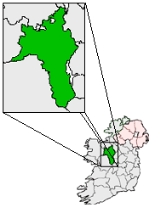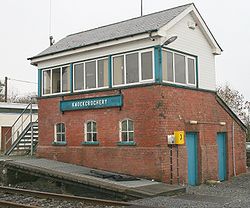
Knockcroghery
Encyclopedia

Village
A village is a clustered human settlement or community, larger than a hamlet with the population ranging from a few hundred to a few thousand , Though often located in rural areas, the term urban village is also applied to certain urban neighbourhoods, such as the West Village in Manhattan, New...
in County Roscommon
County Roscommon
County Roscommon is a county in Ireland. It is located in the West Region and is also part of the province of Connacht. It is named after the town of Roscommon. Roscommon County Council is the local authority for the county...
, Ireland
Republic of Ireland
Ireland , described as the Republic of Ireland , is a sovereign state in Europe occupying approximately five-sixths of the island of the same name. Its capital is Dublin. Ireland, which had a population of 4.58 million in 2011, is a constitutional republic governed as a parliamentary democracy,...
. It is located on the N61 road
N61 road (Ireland)
The N61 road is a national secondary road in County Roscommon, Ireland, linking the N4, N5 and N6 national primary roads.-Route:Starting at Athlone , the road goes Northwards to Knockcroghery, Roscommon, Tulsk , and ends just North of Boyle at the N4....
between Athlone and Roscommon town
Roscommon
Roscommon is the county town of County Roscommon in Ireland. Its population at the 2006 census stood at 5,017 . The town is located near the junctions of the N60, N61 and N63 roads.-History:...
, near Lough Ree on the River Shannon.
Name
The village nestles at the foot of a stony ridge, which protects it from the east wind that sweeps in from Galey Bay. This accountsfor the original name of the village, "Creggan" .
The name change of the village occurred in Cromwellian times (16th Century) when Sir Charles Coote
Charles Coote, 1st Earl of Mountrath
Charles Coote, 1st Earl of Mountrath , was an Irish peer, the younger was the son of Charles Coote and Dorothea Cuffe, the former being a veteran of the battle of Kinsale who subsequently settled in Ireland....
laid siege to Galey Castle; the garrison (O’ Kelly/O’ Ceallaigh chief and clan) resisted and for their defiance were taken to Creggan and hanged. To mark this infamous act the name of the village was changed to ‘Cnoc na Crocaire,’ the Hill of the Hangings, now anglicised as ‘Knockcroghery’..
Economy
For over 250 years the village was famous for the production of the tobacco clay pipe, or "Dúidín". By the late 1800s there were up to 100 people involved in the manufacture and distribution of the village’s clay pipes. Production ceased abruptly on 19 June 1921 when the village was burned down by the Black and TansBlack and Tans
The Black and Tans was one of two newly recruited bodies, composed largely of British World War I veterans, employed by the Royal Irish Constabulary as Temporary Constables from 1920 to 1921 to suppress revolution in Ireland...
during the Irish War of Independence.
Knockcroghery is also known for its clay-pipe making. Today, a visitor centre and workshop are located on the original site of Andrew and P.J. Curley’s pipe factory, where pipes are handcrafted using the original methods of production. The clay-pipe visitors centre is located in the middle of the village and sells clay-pipes and other hand-crafted souvenirs.
Places of interest
- Nearby at Gailey Bay on the shoreShoreA shore or shoreline is the fringe of land at the edge of a large body of water, such as an ocean, sea, or lake. In Physical Oceanography a shore is the wider fringe that is geologically modified by the action of the body of water past and present, while the beach is at the edge of the shore,...
of Lough ReeLough ReeLough Ree is a lake in the midlands of Ireland, the second of the three major lakes on the River Shannon. Lough Ree is the second largest lake on the Shannon after Lough Derg. The other two major lakes are Lough Allen to the north, and Lough Derg to the south, there are also several minor lakes...
, stands Gailey Castle, built in the 14th century. Out in the lake is the islandIslandAn island or isle is any piece of sub-continental land that is surrounded by water. Very small islands such as emergent land features on atolls can be called islets, cays or keys. An island in a river or lake may be called an eyot , or holm...
of Inishcleraun named after a sister of Queen MaeveMedbMedb – Middle Irish: Meḋḃ, Meaḋḃ; early modern Irish: Meadhbh ; reformed modern Irish Méabh, Medbh; sometimes Anglicised Maeve, Maev or Maive – is queen of Connacht in the Ulster Cycle of Irish mythology...
, Clothra. Queen Maeve is said to have been killed here by an enemy while she was bathing. - PortrunPortrunPortrun is a lakeside village, located on the bank of Lough Ree on the River Shannon in Co. Roscommon.It has mooring facilities for boats, and is a popular resort in the Summer months....
is the local lakeside resort, and is popular with tourists and locals alike in the Summer months.
- Also in the area stands Scregg House, seat of the Kelly family. On the grounds of the house are some excellent examples of Sheela na GigSheela Na GigSheela na gigs are figurative carvings of naked women displaying an exaggerated vulva. They are found on churches, castles and other buildings, particularly in Ireland and Britain, sometimes together with male figures. One of the best examples may be found in the Round Tower at Rattoo, in County...
s. The building itself is an example of a 3-storey 5-bay mid-18th century country house.
Architecture
- St. Patrick's Catholic Church was built circa. 1870, and is an example of late nineteenth-century ecclesiastical design. It features a two-stage bell tower with pinnacles and a more recently added copper spire.
People
Knockcroghery is known by many as the home of Roscommon's famous All-IrelandAll-Ireland Senior Football Championship
The All-Ireland Senior Football Championship, the premier competition in Gaelic football, is a series of games organised by the Gaelic Athletic Association and played during the summer and early autumn...
winning captain Jimmy Murray
Jimmy Murray (Gaelic footballer)
Jimmy Murray was an Irish sportsperson who played Gaelic football with Roscommon in the 1940s.-Early & private life:...
(5 May 1917 - 23 January 2007). He captained Roscommon to their only two All-Ireland Senior Football title wins in 1943 and 1944. He was also captain in their 1946 final and replay against Kerry. As the 1943 final also went to a replay, he is the only man to have captained a team in five All-Ireland senior football finals. His public house is a well-known landmark and revered by lovers of Gaelic football from all parts of Ireland.
The Burning of Knockcroghery
In the early hours of the 19 June 1921, the Black and Tans set Knockcroghery village alight. It was an act of vengeance for the killing of a British General in GlassanGlassan
Glassan is a small village of 216 inhabitants in rural County Westmeath, Ireland. It is north of Athlone, on the N55 national secondary road, not far from the shores of Lough Ree...
two days previously by the Westmeath Volunteers. British intelligence agents mistakenly believed that the killers had come from Knockcroghery.
The Black and Tans arrived in four lorries and parked at St. Patrick's Church. Reportedly drunk, they fired shots into the air and ordered the people out of their homes. They easily set fire to the thatched roofs of the cottages, using petrol. They were less successful in setting Murray's, Flanagan's and the priest's houses alight, due to their slated roofs.
Having no time to take their possessions with them, the people rushed from their houses onto the street, still in their nightshirts.
Unable to set Murray's roof alight, the Black and Tans set fire to the back door. John Murray reacted quickly to put the fire out, saving the house. The occupants of the thatched houses didn't have this opportunity, however, the houses burning to the ground very quickly.
Michael O' Callaghan described the scene: "the raiding forces drove up and down the village, firing shots at random, cursing loudly, and laughing at the plight of the people of Knockcroghery. The people were terrified, particularly the children, whose cries of fear added to the terrible scene."
The flames above Knockcroghery alerted the people for miles around to what had happened, and by daylight, the street was full of people. Jamesie Murray remembered the assistance given to the now homeless people of Knockcroghery: "They came from all over to help. People brought clothes, and a fund was soon set up. The families who were now homeless were accommodated in the vicinity, many staying with relatives who lived nearby. Farm sheds were converted into temporary dwellings. Later, three or four new cottages were built on the Shrah road and given to bachelors, who then took people in."
The village was rebuilt over the next few years, with help from government grants. The rebuilding provided employment locally, at a time when it was needed.
Events
The Knockcroghery Fair is a festival held annually, generally on the third weekend in September, which attracts people from all over Ireland.Transport
- Knockcroghery railway station opened on 13 February 1860 and finally closed on 17 June 1963.
- Knockcroghery is situated on the main N61 roadN61 road (Ireland)The N61 road is a national secondary road in County Roscommon, Ireland, linking the N4, N5 and N6 national primary roads.-Route:Starting at Athlone , the road goes Northwards to Knockcroghery, Roscommon, Tulsk , and ends just North of Boyle at the N4....
between Athlone and Roscommon towns, and near the M6 Galway-Dublin motorway.
See also
- RoscommonRoscommonRoscommon is the county town of County Roscommon in Ireland. Its population at the 2006 census stood at 5,017 . The town is located near the junctions of the N60, N61 and N63 roads.-History:...
- County RoscommonCounty RoscommonCounty Roscommon is a county in Ireland. It is located in the West Region and is also part of the province of Connacht. It is named after the town of Roscommon. Roscommon County Council is the local authority for the county...
- Athlone
- List of towns and villages in
Ireland
External links
- Sheela na Gigs at Scregg
- Clay Pipe Visitors Centre
- Gailey Bay Caravan & Camping Park, Knockcroghery.
- Roscommon.ie - Online Resource for Visitors and Locals alike.
- St. Dominics GAA club - Local Gaelic Athletic AssociationGaelic Athletic AssociationThe Gaelic Athletic Association is an amateur Irish and international cultural and sporting organisation focused primarily on promoting Gaelic games, which include the traditional Irish sports of hurling, camogie, Gaelic football, handball and rounders...
club. - Discover Ireland - For Tourists.

